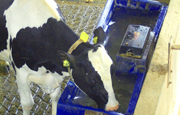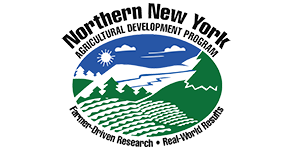
Chazy, N.Y.; June 12, 2020. Dairy farms can take simple measures to reduce the impact of heat stress on dairy cows and protect their milk production, according to research funded by the Northern New York Agricultural Development Program (NNYADP) and conducted by the W. H. Miner Agricultural Research Institute. The latest results report, comparing heat abatement systems on four dairy farms in northern New York, is posted under the Research: Dairy tab at www.nnyagdev.org.
“This research addresses climatic trends that create episodic bouts of heat stress that do not allow dairy animals time to acclimate. We are working with regional farms to develop a science-based understanding of heat stress that will help farmers enhance their heat abatement systems to increase cow comfort and maintain strong milk production,” said Miner Institute Director of Research Katie Ballard.
On one of the four farms in the NNYADP-funded study, improving air movement through the barn resulted in one hour more of cow lying time during hot weather.
“A one-hour increase in lying time represents the opportunity for 2 to 3-and-a-half more pounds of milk per day per cow,” Ballard said.
The farm increased the downward angle of fans over stall beds and closed doors at one end of the barn to create more air movement within the cow pens. Wind speed directed over the cows and water availability appeared to be key factors that improved cooling during hot weather.
The average internal, or reticular, body temperature of the cows on the farm increased by only 0.4 degrees Fahrenheit during hot weather and showed little fluctuation during the day with just slightly elevated media reticular temperature on the hottest days.
On three farms, the action of milking and/or moving cows to a holding area with fans and sprinklers appeared to reduce the cows’ body temperature. Heat abatement measures on two of the farms were effective during mild heat events when the humidity index was below 72.

“When temperature and humidity rise to certain levels, taking measures to cool your cows helps maintain their dry matter intake and rumination which translates to maintaining milk production. Cooling also encourages lying time which helps reduce lameness,” Ballard noted. “Water availability also plays a critical role in helping cows maintain a comfortable core body temperature.”
The results of earlier NNYADP heat stress research conducted on the participating farms showed that periods of heat stress decreased bulk tank milk protein levels. Greater than 40 percent of the variability in milk protein percentage was associated with the temperature humidity index on farms where cows appeared the most vulnerable to heat stress during hot weather events in 2016 to 2018.
Researchers with Ohio State University and the University of Illinois have estimated that heat stress in cows costs the U.S. dairy industry approximately $900 million in economic losses annually.
 Funding for the Northern New York Agricultural Development Program is supported by the New York State Legislature and administered by the New York State Department of Agriculture and Markets. Learn more at www.nnyagdev.org.
Funding for the Northern New York Agricultural Development Program is supported by the New York State Legislature and administered by the New York State Department of Agriculture and Markets. Learn more at www.nnyagdev.org.